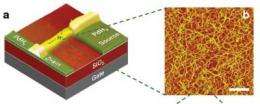Proton-based transistor could let machines communicate with living things

Human devices, from light bulbs to iPods, send information using electrons. Human bodies and all other living things, on the other hand, send signals and perform work using ions or protons.
Materials scientists at the University of Washington have built a novel transistor that uses protons, creating a key piece for devices that can communicate directly with living things. The study is published online this week in the interdisciplinary journal Nature Communications.
Devices that connect with the human body's processes are being explored for biological sensing or for prosthetics, but they typically communicate using electrons, which are negatively charged particles, rather than protons, which are positively charged hydrogen atoms, or ions, which are atoms with positive or negative charge.
"So there's always this issue, a challenge, at the interface – how does an electronic signal translate into an ionic signal, or vice versa?" said lead author Marco Rolandi, a UW assistant professor of materials science and engineering. "We found a biomaterial that is very good at conducting protons, and allows the potential to interface with living systems."
In the body, protons activate "on" and "off" switches and are key players in biological energy transfer. Ions open and close channels in the cell membrane to pump things in and out of the cell. Animals including humans use ions to flex their muscles and transmit brain signals. A machine that was compatible with a living system in this way could, in the short term, monitor such processes. Someday it could generate proton currents to control certain functions directly.
A first step toward this type of control is a transistor that can send pulses of proton current. The prototype device is a field-effect transistor, a basic type of transistor that includes a gate, a drain and a source terminal for the current. The UW prototype is the first such device to use protons. It measures about 5 microns wide, roughly a twentieth the width of a human hair.
"In our device large bioinspired molecules can move protons, and a proton current can be switched on and off, in a way that's completely analogous to an electronic current in any other field effect transistor," Rolandi said.
The device uses a modified form of the compound chitosan originally extracted from squid pen, a structure that survives from when squids had shells. The material is compatible with living things, is easily manufactured, and can be recycled from crab shells and squid pen discarded by the food industry.
First author Chao Zhong, a UW postdoctoral researcher, and second author Yingxin Deng, a UW graduate student, discovered that this form of chitosan works remarkably well at moving protons. The chitosan absorbs water and forms many hydrogen bonds; protons are then able to hop from one hydrogen bond to the next.
Computer models of charge transport developed by co-authors M.P. Anantram, a UW professor of electrical engineering, and Anita Fadavi Roudsari at Canada's University of Waterloo, were a good match for the experimental results.
"So we now have a protonic parallel to electronic circuitry that we actually start to understand rather well," Rolandi said.
Applications in the next decade or so, Rolandi said, would likely be for direct sensing of cells in a laboratory. The current prototype has a silicon base and could not be used in a human body. Longer term, however, a biocompatible version could be implanted directly in living things to monitor, or even control, certain biological processes directly.
Provided by University of Washington

















